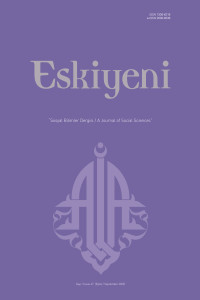Öz
Anahtar Kelimeler
Philosophy of Religion Christianity Trinity Person Split-Brain Case
Kaynakça
- Bayne, Tim. The Unity of Consciousness. New York: Oxford University Press, 2010. https://doi.org/10.1093/acprof:oso/9780199215386.001.0001
- Beau Branson. “No New Solutions to the Logical Problem of the Trinity”. Journal of Applied Logics 6/6 (2019), 1051-1091.
- Brower, Jeffrey E. - Rea, Michael C. “Understanding the Trinity”. Logos 8/1 (2005), 145-157. https://doi.org/10.1353/log.2005.0003
- Churchland, Patricia Smith. Neurophilosophy. London: The MIT Press, 1989.
- Deutsch, Harry - Garbacz, Pawel. “Relative Identity”. ed. Edward N. Zalta. Stanford Encyclo¬pedia of Philosophy. 2018. Erişim 16 Kasım 2020. https://plato.stanford.edu/archives/fall2018/entries/identity-relative/
- Eccles, John C. “The Self and Its Brain”. The Self and Its Brain. ed. Karl Popper - John C. Eccles. 225-406. Springer International Publishing, 1977. https://doi.org/10.4324/9780203537480
- Gazzaniga, Michael S. - Ledoux, Joseph E. The Integrated Mind. New York: Springer Science+Business Media, 3. Basım, 1981.
- Geach, Peter. Logic Matters. Oxford: Basil Blackwell, 1972.
- Hasker, William. Metaphysics and the Tri-Personal God. Ithaca: Cornell University Press, 2013.
- Inwagen, Peter Van. “And Yet They are not Three Gods but One”. God, Knowledge and Mystery. ed. Peter van Inwagen. 222-260. Ithaca: Cornell University Press, 1995. https://doi.org/10.7591/9781501745324-012
- Inwagen, Peter Van. “Three Persons in One Being: On Attempts to Show that the Doctrine of the Trinity is Self-Contradictory”. The Trinity. ed. Melville Y. Stewart. 83-97. Springer, 2003. https://doi.org/10.1007/978- 94-017-0393-2_9
- Lehrer, Jonah. Karar Ânı. çev. Ferit Burak Aydar. İstanbul: Boğaziçi Üniversitesi Yayınları, 2016.
- Merricks, Trenton. “Split Brains and the Godhead”. Knowledge and Reality: Essays in Honor of Alvin Plantinga. ed. Thomas M. Crisp vd. 299-326. Dordrecht: Springer, 2006. https://doi.org/10.1007/1-4020-4733- 9_13
- Mosser, Carl. “Fully Social Trinitarianism”. Philosophical and Theological Essays on the Trinity. ed. Michael Rea - Thomas McCall. 131-150. New York: Oxford University Press, 2009. https://doi.org/10.1093/acprof:oso/9780199216215.003.0008
- Nagel, Thomas. “Brain Bisection and the Unity of Consciousness”. Synthese 22/3-4 (1971), 396-413. https://doi.org/10.1007/bf00413435
- Parfit, Derek. Reasons and Persons. New York: Oxford University Press, Reprint., 1987. https://doi.org/10.1093/019824908X.001.0001
- Rea, Michael. “Relative Identity and the Doctrine of the Trinity”. Philosophia Christi 5/2 (2003), 431-446. https://doi.org/10.5840/pc20035247
- Swinburne, Richard. “Could There be More Than One God?” Faith and Philosophy: Journal of the Society of Christian Philosophers 5/3 (1988), 225-241. https://doi.org/10.5840/faithphil19885332
- Swinburne, Richard. “The Social Theory of the Trinity”. Religious Studies 54/3 (2018), 419-437. https://doi.org/10.1017/S0034412518000203
Öz
Anahtar Kelimeler
Din Felsefesi Hristiyanlık Teslis Kişi Kavramı Ayrık-Beyin Vakası
Kaynakça
- Bayne, Tim. The Unity of Consciousness. New York: Oxford University Press, 2010. https://doi.org/10.1093/acprof:oso/9780199215386.001.0001
- Beau Branson. “No New Solutions to the Logical Problem of the Trinity”. Journal of Applied Logics 6/6 (2019), 1051-1091.
- Brower, Jeffrey E. - Rea, Michael C. “Understanding the Trinity”. Logos 8/1 (2005), 145-157. https://doi.org/10.1353/log.2005.0003
- Churchland, Patricia Smith. Neurophilosophy. London: The MIT Press, 1989.
- Deutsch, Harry - Garbacz, Pawel. “Relative Identity”. ed. Edward N. Zalta. Stanford Encyclo¬pedia of Philosophy. 2018. Erişim 16 Kasım 2020. https://plato.stanford.edu/archives/fall2018/entries/identity-relative/
- Eccles, John C. “The Self and Its Brain”. The Self and Its Brain. ed. Karl Popper - John C. Eccles. 225-406. Springer International Publishing, 1977. https://doi.org/10.4324/9780203537480
- Gazzaniga, Michael S. - Ledoux, Joseph E. The Integrated Mind. New York: Springer Science+Business Media, 3. Basım, 1981.
- Geach, Peter. Logic Matters. Oxford: Basil Blackwell, 1972.
- Hasker, William. Metaphysics and the Tri-Personal God. Ithaca: Cornell University Press, 2013.
- Inwagen, Peter Van. “And Yet They are not Three Gods but One”. God, Knowledge and Mystery. ed. Peter van Inwagen. 222-260. Ithaca: Cornell University Press, 1995. https://doi.org/10.7591/9781501745324-012
- Inwagen, Peter Van. “Three Persons in One Being: On Attempts to Show that the Doctrine of the Trinity is Self-Contradictory”. The Trinity. ed. Melville Y. Stewart. 83-97. Springer, 2003. https://doi.org/10.1007/978- 94-017-0393-2_9
- Lehrer, Jonah. Karar Ânı. çev. Ferit Burak Aydar. İstanbul: Boğaziçi Üniversitesi Yayınları, 2016.
- Merricks, Trenton. “Split Brains and the Godhead”. Knowledge and Reality: Essays in Honor of Alvin Plantinga. ed. Thomas M. Crisp vd. 299-326. Dordrecht: Springer, 2006. https://doi.org/10.1007/1-4020-4733- 9_13
- Mosser, Carl. “Fully Social Trinitarianism”. Philosophical and Theological Essays on the Trinity. ed. Michael Rea - Thomas McCall. 131-150. New York: Oxford University Press, 2009. https://doi.org/10.1093/acprof:oso/9780199216215.003.0008
- Nagel, Thomas. “Brain Bisection and the Unity of Consciousness”. Synthese 22/3-4 (1971), 396-413. https://doi.org/10.1007/bf00413435
- Parfit, Derek. Reasons and Persons. New York: Oxford University Press, Reprint., 1987. https://doi.org/10.1093/019824908X.001.0001
- Rea, Michael. “Relative Identity and the Doctrine of the Trinity”. Philosophia Christi 5/2 (2003), 431-446. https://doi.org/10.5840/pc20035247
- Swinburne, Richard. “Could There be More Than One God?” Faith and Philosophy: Journal of the Society of Christian Philosophers 5/3 (1988), 225-241. https://doi.org/10.5840/faithphil19885332
- Swinburne, Richard. “The Social Theory of the Trinity”. Religious Studies 54/3 (2018), 419-437. https://doi.org/10.1017/S0034412518000203
Ayrıntılar
| Birincil Dil | Türkçe |
|---|---|
| Konular | Din Araştırmaları |
| Bölüm | Makaleler |
| Yazarlar | |
| Yayımlanma Tarihi | 25 Eylül 2022 |
| Gönderilme Tarihi | 21 Aralık 2021 |
| Yayımlandığı Sayı | Yıl 2022 Sayı: 47 |


